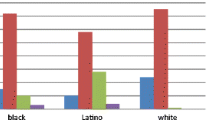Abstract
This article is an exploration of racial differences in the intersegment mobility process in a segmented labor market. To this end, a series of qualitative response models describing mobility of prime-age white and nonwhite males through a tripartite segmented labor market is constructed. It is found that demand variables representing labor market conditions, as well as traditional human capital variables are important predictors of intersegment mobility. It is also evident that there are striking racial differences in intersegment mobility patterns.
Similar content being viewed by others
Notes
Nachum Sicherman and Oded Galor, “A Theory of Career Mobility.”Journal of Political Economy 98(1990): 169–92.
Sam Rosenberg, “Male Occupational Standing and the Dual Labor Market.”Industrial Relations 19 (1980): 35–49 and R. W. Rumberger and M. Carnoy, “Segmentation in the U. S. Labour Market: Its Effects on the Mobility and Earnings of Whites and Blacks.”Cambridge Journal of Economics 4 (1980): 117–32.
Rumberger and Carnoy, “Segmentation.”
Sam Rosenberg, “Economic Contractions and Racial Differentials in Male Job Mobility.”Industrial Relations 26 (1987): 291–95.
Michael Piore, “Notes for a Theory of Labor Market Stratification,” in Richard C. Edwards, Michael Reich, and David Gordon eds.,Labor Market Segmentation (Lexington, MA: D.C. Heath, 1975), 125–50 and David M. Gordon, Richard Edwards and Michael Reich,Segmented Work, Divided Workers: The Historical Transformation of Labor in the United States (New York: Cambridge University Press, 1982), 212.
Gerry Oster, “A Factor Analytic Test of the Theory of the Dual Economy.”Review of Economics and Statistics 62 (1979): 33–39. Oster defines core industries as those which tend to be relatively more concentrated, capital intensive, unionized and technologically progressive. Peripheral industries are marked by the relative absence of these characteristics.
Rumberger and Carnoy, “Segmentation.”
Barry Bluestone and Bennett Harrison,The Great U-Turn: Corporate Restructuring and the Polarizing of America (New York: Basic Books Inc. 1988).
Sicherman and Galor, “A Theory of Career Mobility.”
Samuel Bowles and Herbert Gintis,Schooling in Capitalist America (New York: Basic Books, 1976).
Piore, “Notes for a Theory,” and Thomas Vietorisz and Bennett Harrison, “Labor Market Segmentation: Positive Feedback and Divergent Development,”American Economic Review 63 (1973): 366–76.
See Takeshi Amemiya, “Qualitative Response Models: A Survey,”Journal of Economic Literature 19 (1981): 1483–1536 who suggests using either the logit or probit models for the sort of qualitative response model outlined here. In bivariate response models there is little statistical difference in the results of the logit and probit models.
Logistic regressions combining the two racial groups are estimated elsewhere. Included in these estimations is a variable controlling for race. In all but the m21 equations the race variable is a statistically significant predictor of the probability of intersegment mobility. For upward transitions, the racial effect is uniformly negative, while for downward transitions it is uniformly positive. These results suggest that being nonwhite is correlated negatively to upward mobility and positively to downward mobility through the segment structure. Chow tests conducted from a series of linear probability models modeling intersegment mobility, however, indicate that separate regressions should be estimated for the two racial groups. See Jeffrey Waddoups,Mobility in a Segmented Labor Market, unpublished doctoral dissertation, University of Utah, (1989).
Bluestone and Harrison,The Great U-Turn.
Vietorisz and Harrison, “Labor Market Segmentation.”
Rumberger and Carnoy, “Segmentation,” and Rosenberg, “Male Occupational Standing.”
David M. Gordon, “Procedure for Allocating Jobs into Labor Segments,” unpublished working paper, The New School for Social Research (May 1986).
The Gordon method of allocation of occupations into segments yields results similar to those in other related studies, e.g., Rumberger and Carnoy, and David M. Gordon, Richard Edwards and Michael Reich,Segmented Work, Divided Workers.
See footnote 6 for definition of core and peripheral industries.
Additional information
This paper was written with financial support from the Marriner S. Eccles Grant for research in political economy. Also, partial support was received from First Interstate Bank.
About this article
Cite this article
Waddoups, J. Racial differences in intersegment mobility. The Review of Black Political Economy 20, 23–43 (1991). https://doi.org/10.1007/BF02689925
Issue Date:
DOI: https://doi.org/10.1007/BF02689925




